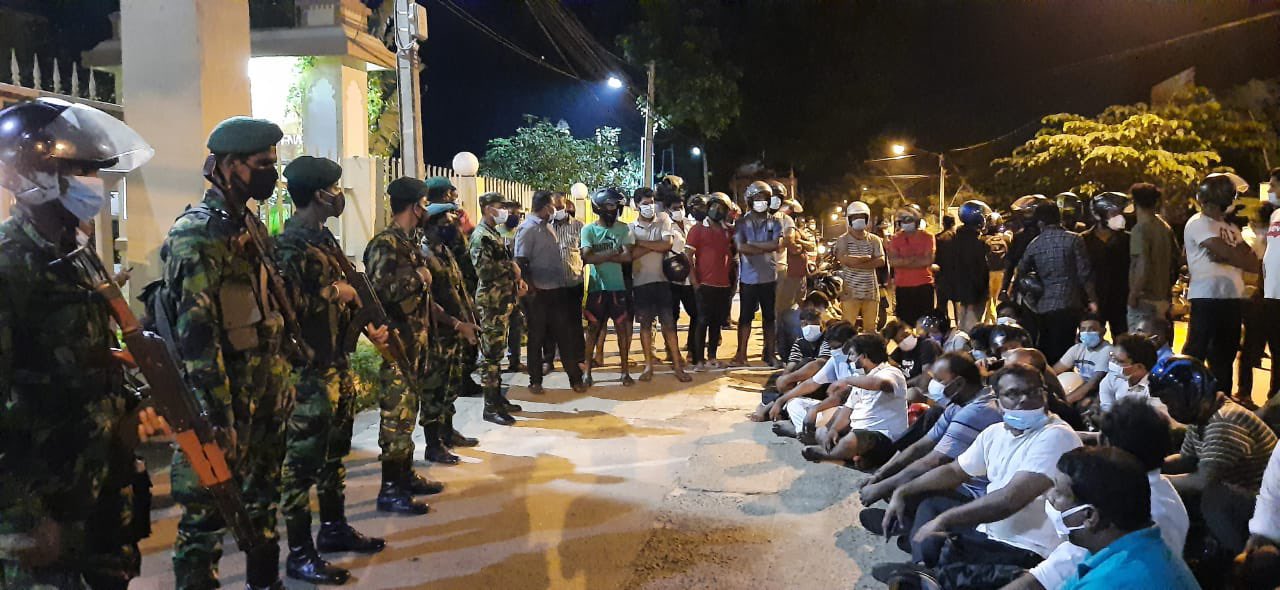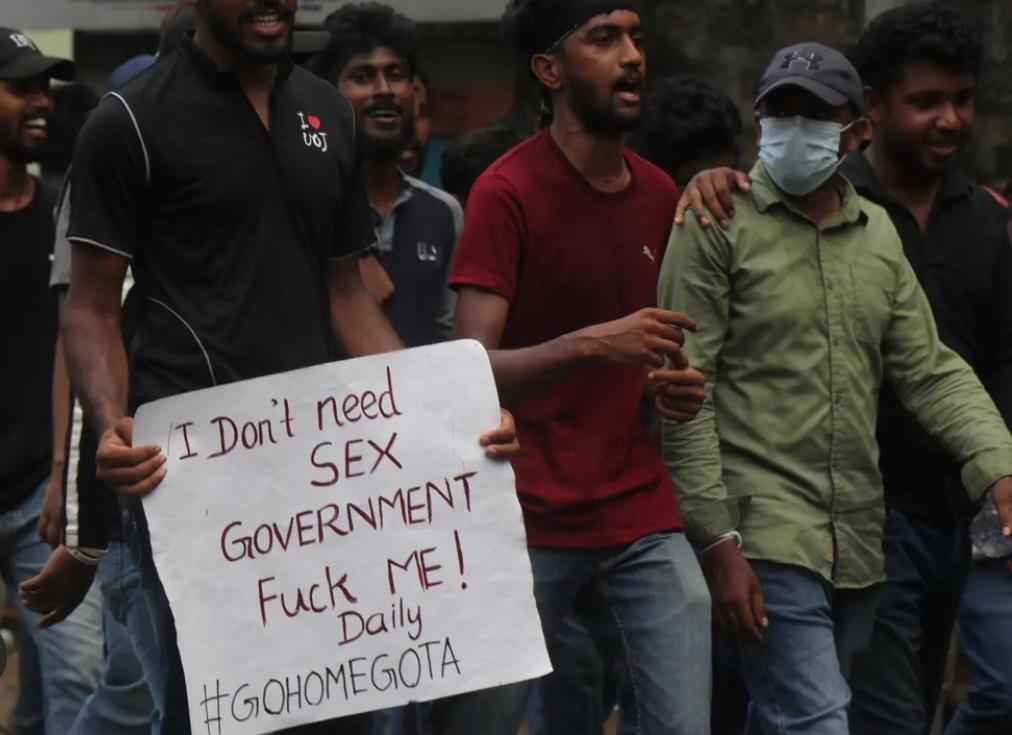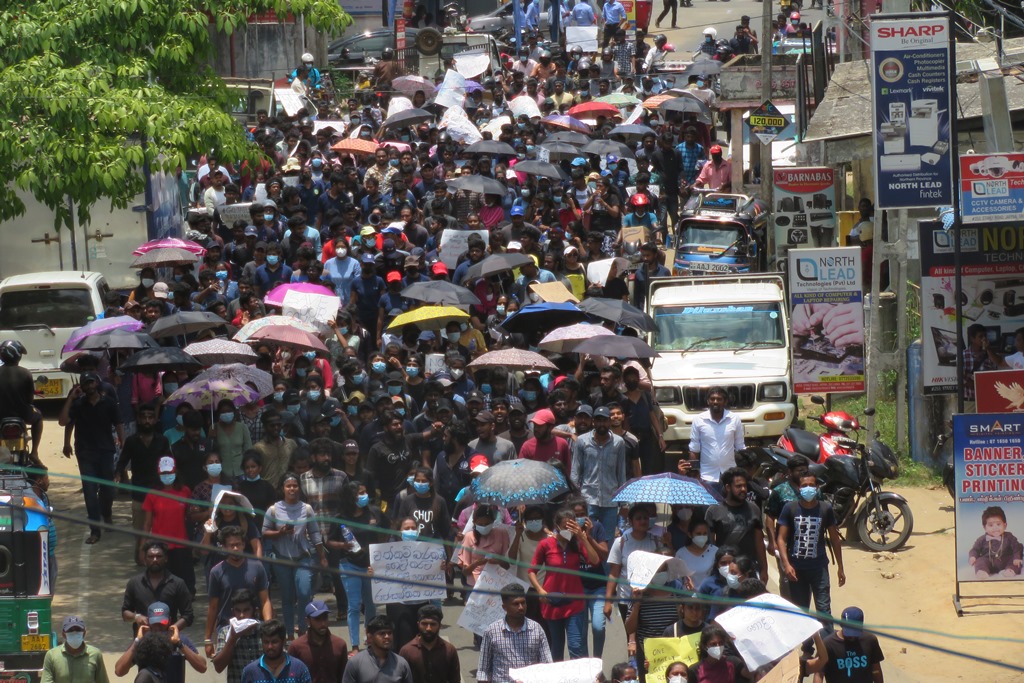
Protesters in front of Sri Lanka's Presidential Secretariat.
April 16, 2022
By Dr. S. I. Keethaponcalan
Sri Lanka slipped into an economic crisis with socio-political implications in March 2022. I have explained the crux of the issue in an essay titled “The Sri Lankan Crisis: A Sinhala Civil War?” published in Eurasiareview on April 3, 2022. The root cause of the issue was the dwindling of the foreign reserve, which led to severe scarcity of essential consumer products. The long queues frustrated the masses. They blamed the incumbent government, headed by President Gotabaya Rajapaksa and Prime Minister Mahinda Rajapaksa, for the crisis. The Rajapaksa family came under severe criticism. The family’s omnipresence in all sectors of the government and their control was one of the reasons for the focus on “the family.” Although the government policies immensely contributed to the crisis, the critics focused on the alleged corruption. They claimed that the family looted the country. In their view, the alleged robbery is the reason for the present predicament.
The Protest
Initially, small groups of people gathered in their localities against the government. On March 31, protesters turned up in front of President Gotabaya Rajapaksa’s private residence and demanded his resignation. They chanted “go-home-gota.” The protest turned violent. The nationwide protest called for on April 3 could not be carried on because of the curfew and the emergency regulations the government introduced using the March 31 troubles as an excuse. The government lifted the emergency regulations on April 6, presumably due to the fear that it could not be approved in Parliament due to the recent defections.
Instead of reorganizing the nationwide demonstration, the protesters gathered in front of the presidential secretariat in Colombo near the famous Galle Face Green (GFG). Now, the GFG has turned into the center of the anti-government protest. They occupy the GFG in the style of the Occupy Wall Street protest undertaken in the United States several years back (2011). The site has been named the “Gota Go Gama.” (Gota Go Village).
What do the protesters want? The protest started with the slogan, go-home-gota, which means that the president should step down and perhaps return to the US. The protesters also want all members of the Rajapaksa clan out of the government. The protest slogan was recently expanded to recover the (allegedly) stolen money and resources by the Rajapaksa family. Some of them now demand that political figures of the family should go to jail. Evidently, the slogans are transforming and expanding constantly. However, it is safe to assume that the protesters want the present government, including Prime Minister Mahinda Rajapaksa and President Rajapaksa, out immediately.
There are two additional significant aspects to the Occupy GFG movement or what some call the go-home-gota movement. One, it has brought different ethnic, racial, and social groups together against the Rajapaksa clan. As a result, Sri Lanka witnessed a rare moment of social solidarity. Sri Lankan politicians (with the help of the voters) have systematically fragmented the Sri Lankan social fabric for political objectives. This project has at least temporarily been defeated by the Occupy GFG movement. Two, the protesters are hurling savage insults at the Rajapaksa family. While addressing the nation on April 11, Prime Minister Rajapaksa acknowledged the abuses he and his family have absorbed. The insults hurt. Rajapaksa once believed that he would be loved by the Sinhala people forever. This is why he tried to add his name to the Mahavamsa.
Two options are available to the protesters if unseating the present government is the central goal. They are: (1) achieving the goal through legal and constitutional means, and (2) focusing on a moral argument. Both seem problematic at this point.
Legal Means
In terms of unseating the government legally, two main instruments are available: (1) bringing down the cabinet headed by Mahinda Rajapaksa through a no-confidence motion (NCM), and (2) impeaching the president. It is important to note that in Sri Lanka, the government has two main components: the president and the cabinet, both elected directly by the people in different elections. Therefore, from the vantage point of the protesters, both need to be targeted simultaneously.
Removing the cabinet through an NCM requires 113 votes in the 225-seat national legislature. Newspaper reports indicate that the opposition political parties are in the process of introducing the NCM, and Opposition leader Sajith Premadasa has already signed the motion. Adopting the NCM in Parliament would be a daunting task because the government won a (near) two-thirds majority in the last (August 2020) parliamentary election. The nature of the electoral victory of the Sri Lanka Podujana Peramuna (SLPP) in the previous election makes it extremely hard to bring the cabinet down through an NCM. Therefore, the protesters, most of whom voted for the SLPP, are partly responsible for the current stalemate. An “ordinary win” in 2020 would have already brought this cabinet down.
The current parliamentary arithmetic indicates that the opposition parties need to get the endorsement of about 40 SLPP members or allies to adopt the NCM successfully. The recent defection of, for example, the Sri Lanka Freedom Party (SLFP), the Pivithuru Hela Urumaya (PHU), and Jathika Nedahas Peramuna (JNP) could help. The defectors claim that they have taken 41 seats from the SLPP, a doubtful assertion. If this is true, the combined opposition in Parliament has about 113 seats, but it is too close for comfort. Moreover, Mahinda Rajapaksa is an expert defection dealer. He had effectively dealt with many defections in the past. Threats, intimidations, and financial inducements will be liberally used to defeat the possible NCM. Therefore, ousting the cabinet through an NCM would not be impossible but not easy.
Removing the president through an impeachment motion will be extremely difficult. One, the impeachment motion should be signed by at least 113 members (not less than one-half of the whole number of Members of Parliament). Two, it should be adopted by a two-thirds majority in Parliament. Three, the Supreme Court should find that the president is “incapable of discharging the functions of his office.” Four, the Parliament should vote (again) with a two-thirds majority to “remove” the president from office. These are not easy steps. Therefore, I do not believe that legally removing the president will be feasible under the current circumstances. What this means is that legally, the protesters are in a bind.
Morality Argument
The second option available to the protesters is to base their struggle on morality, an extralegal method. They seem to be taking this route currently. They argue that since the present government is responsible for the crisis, it should step down. Although reasonable, this approach entails several problems. One, the protesters and the government have fundamentally different views about the causes of the crisis. For example, the government does not agree with the notion that it is responsible for the current mess. While addressing the nation on March 16, the president loudly declared that he did not construct this crisis. Mahinda Rajapaksa also failed to take responsibility in his (belated) address to the nation on April 11. Two, the approach depends on the values of the Rajapaksa family. To be successful, the family should voluntarily step down. Will they step down in the best interest of the country? Keen observers of the Rajapaksa family’s politics and governing philosophies know that they will not voluntarily (i.e., without adequate pressure) give up power. Three, voluntarily stepping down now could also mean the end of politics for the Rajapaksa clan members. Therefore, they will use all their power to remain in government until the next regular election. An electoral deaf would allow them to regroup and return. President Rajapaksa and Prime Minister Rajapaksa have provided adequate indications that they intend to stay on and fight. The point here is that the government is unlikely to step down voluntarily. This means that the morality-based approach is unlikely to yield results.
Elitist Entertainment?
The Occupy GFG movement has narrowed the struggle rather than expanding it. On April 3, it had the potential to create a nationwide spectacle. Instead of reorganizing the nationwide campaign, the protesters focused on a highly narrow geographical area, the Gale Face Green. I am sure President Rajapaksa would have already moved his operations to somewhere else. The protesters are also ignoring some of the traditional and impactful direct-action strategies of Sri Lankans. For example, Sri Lankans are masters of using hunger strikes for social and political change. This strategy is ignored.
Moreover, the Occupy GFG movement is transforming into elitist entertainment. There are positives and negatives to making it elitist entrainment. The danger is that it could turn into another Occupy Wall Street Movement, which dissipated after the immediate euphoria. The protesters will not be able to keep up the momentum with the current long-term strategy. It will fizzle out, especially if/when the supply of essential commodities increases. I believe that there is a negative correlation between the supply of essential commodities and protest. I am also sure that the government depends on this reality.
Ideally, what Sri Lanka needs today is fresh elections to both the president and parliament. New thinking and approaches are fundamental to the effective resolution of the crisis. Unfortunately, the present government is incapable of inducing anything new, a problem. In a fresh election, citizens will have an opportunity to vote for the best program presented to resolve the crisis. Demanding new elections is democratic, reasonable, and practical. Therefore, the Sri Lankan protesters need to rethink their slogan and strategies.

Dr. S. I. Keethaponcalan is Chair of the Conflict Resolution Department, Salisbury University, Maryland. Email: skeetha@yahoo.com
Speaking in parliament, leader of the Tamil National Peoples' Front (TNPF) Gajendrakumar Ponnambalam called into question Sri Lanka’s exorbitant military spending of 10.35% of the annual budget
“10.35% in a situation where there is no war” he stated. “Who is your enemy?”
“No country has attacked Sri Lanka, no your enemy is within. You consider your own citizens as enemies. Why? Because you don't want to recognise their rights, you would rather kill them, you’d rather wage war than have them become productive citizens” he stated.
He added: “Your defence policy is based on making sure the Tamils don't get their rights. Your foreign policy is based on making sure the Tamils don't get their rights”.
Commenting on rampant Islamophobia in Sri Lanka, he stated: “This time you've picked another enemy, the Muslims. You need that bogeyman to continue your racist and corrupt policies where only you line your pockets, not the citizens”.
Ponnambalam continued:
“Now you continue to militarise, today you need to militarise to protect against the Sinhalese, the common man”.
“People cannot make ends meet and they will not forgive you. For 73 years you blamed war, and the Tamils and the Muslims. Now there is no more people to blame. This time you will pay a price”.
Ponnambalam concluded stress that:
“There is no point blaming just this government, you have to call into question 73 years of government policy”.
As anti-government protests engulfed the south of Sri Lanka this week, Tamil students at the University of Jaffna have expressed their frustrations at how Sinhalese students had failed to join them at previous protests as they joined a rally through the Northern city on Monday.
“Until now, the community in question have been hibernating,” said one Jaffna University student, speaking on the growing number of Sinhala students at the campus. “Only now, when their people have been submerged in problems, have they woken up, taking strategic action by joining us on the streets.”
Though protests and rallies have flared across the south of the island, the North-East has been relatively subdued. The Daily Mirror claimed that protestors had surrounded the homes of almost every government-aligned parliamentarian in the country, but that was not true across the Tamil homeland.

In recent years, protests have regularly taken place across the North-East on issues ranging from international accountability for genocide to halting government land grabs and the devolution of powers to the Tamil provinces. Whilst dozens were held across the South calling for the resignation of Sri Lanka’s president, few have been held by Tamils in recent days.
In Batticaloa, Tamil parliamentarian R Shanakiyan led a march, whilst students at Eastern University held a demonstration on Monday.
Tamil and Sinhala students also marched in Jaffna on Monday, with placards in Tamil, English and Sinhalese. But some students criticized the lack of support from Sinhala students for Tamil rights and issues.
“During the five years I have studied here, we students have organised countless protests to improve the welfare of our community,” continued the Jaffna-based student. “They did not take part or even come to watch.”

A placard from the protest in Jaffna on Monday.
The student also criticised how some of the Sinhala students’ placards contained curse words or joked about sexual intercourse, particularly given the long history of sexual violence by Sri Lanka’s security forces. “To this day, many protests have taken place at Jaffna University and yet, even when faced with violence, there is no history of raising banners that use language that makes you wrinkle your face in disgust,” he added.
Others have expressed little faith that the protests would amount to any tangible change for Tamils. “Once they get fuel and bread, they will forget all about us,” said another Jaffna local.
“Today, their activism feels farcical in my heart,” continued the student. “Protesting is not new to us… it’s new to them.”

No comments:
Post a Comment